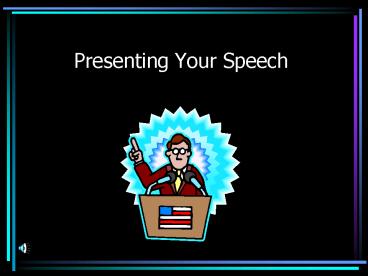Presenting Your Speech - PowerPoint PPT Presentation
1 / 35
Title: Presenting Your Speech
1
Presenting Your Speech
2
Methods of Delivery
- Impromptu Delivery
- Manuscript Delivery
- Memorized Delivery
- Extemporaneous Delivery
3
Impromptu Delivery
- Speech is given on the spur of the moment with
little or no preparation
4
Manuscript Delivery
- Speech is written out
- completely and read to
- the audience
5
Memorized Delivery
- Speech is written out
- and recited word for
- word (without using the
- script)
6
Extemporaneous Delivery
- Speech is fully outlined
- and practiced, but not
- memorized
7
Stage Fright
8
Stage Fright
- The nervousness a speaker feels before and during
the presentation of their speech - A.K.A. Communication Apprehension
9
Stage Fright Facts
- Stage fright is normal. Even experienced speakers
have stage fright. - Some stage fright is beneficial.
- The audience is not likely to notice your
nervousness. - Experience and practice will help control stage
fright.
10
Before your speech...
- Prepare speech carefully and completely
- Look your best
- Relax tense muscles (deep breaths)
- Give yourself a pep-talk
- Be self-assured
11
During the speech
12
Queasy feeling, butterflies, sweaty palms,
general weakness
- May feel strong at first,
- but it will lessen quickly
- once you begin
- Ignore them! These have
- no direct effect on your
- delivery.
13
Dry Mouth
- Licking lips and swallowing will not diminish
dryness but will detract from your appearance -
SO DONT DO IT!! - Start slowly and know that the dryness in your
mouth will subside.
14
Stumbling over words at the start
- Word fumbles often result from trying to recall
the exact words you wrote to express an idea. - Practice saying parts of your speech in different
ways so you will feel comfortable with a variety
of delivery styles.
15
Perspiration, Squeaky voice, Slight trembling
- Ignore these!
- Know that your body WILL return to normal
- Deep breaths before beginning will help
16
Strong desire to quit
- Finish your speech no matter how painful the
experience seems at the moment. - You will build your confidence by proving to
yourself that you can finish the speech.
17
Improving Nonverbal Behavior
18
Appearance
- Appearance is how you look to your audience
- The two key factors are
- Clothing
- Grooming
19
Eye Contact
- Eye contact is direct visual contact with the
eyes of members of your audience - Look randomly at individuals throughout the
entire audience - Remember to divide the room into sections and
make eye contact within each section
20
Facial Expressions
- Facial expressions give clues to your audience
about the content of your speech. - Concentrating on what you are saying rather than
the fact that you are trying to give a speech
will help you avoid the 2 common expression
problems. They are
21
- Deadpan- expressionless facial appearance that
never changes, regardless of what is being said - Conflicting expression- facial appearance that
does not match a speakers words or actual
feelings
22
Effective Gestures
- Use natural gestures, do not think, What should
I do with my hands? - Try not to have too many gestures - they become
distracting.
23
Good Posture
- Good posture creates an impression of confidence
and authority. - Stand straight with both feet firmly on the
ground-never slump, slouch, or look sloppy.
24
Improving Vocal Skills
25
Enthusiasm
- Enthusiasm is the strong positive feelings
speakers show for their topic. - You will be enthusiastic if you believe
- Your topic is a good one
- You have found excellent supporting material
- Your audience will be interested in the material
26
Vocalized Pauses
- Vocalized pauses are meaningless speech sounds
that speakers use to fill time (Uh, Umm,
Well..And..) - Vocalized pauses are undesirable.
27
- Likely to be used when you are
- Unprepared
- Searching for a right word
- flustered or embarrassed
- in too much of a hurry
28
How to decrease their use
- Find out whether you overuse them (if the
audience notices them, you are overusing them)
29
- Train your ear to hear your vocalized pauses
- Practice and have a partner hold up their hand
every time you use a vocalized pause. By having
your attention drawn to them, you will begin to
tune your ear to them.
30
- Train yourself to speak with fewer vocalized
pauses (Once you train yourself to limit their
use during rehearsals, you will be able to limit
their use during your speech.)
31
Articulation, Pronunciation, and Enunciation
- Articulation- Shaping of distinct speech sounds
into recognizable words - Pronunciation- Grouping and accenting of the
sounds - Enunciation- Refers to the distinctness of the
sounds you make. Ex. probly rather than
probably, gimme for give me
32
Improving Verbal Messages
33
Diction
- Diction refers to both the words a speaker
selects and the specific ways in which the
speaker uses these words - Your words should be
- specific and concrete
- vivid so it allows audience to picture what you
are saying - place emphasis on important things
- Avoid cliches and slang words
34
Grammar
- Grammar refers to the rules and conventions for
speaking and writing English - Formal speeches require the use of Standard
American English
35
No Slang!!!































